| Home | Nature Weekly Index |
20 July 2014 | Beetle & Bug | Air Potato Vine (Dioscorea bulbifera) |
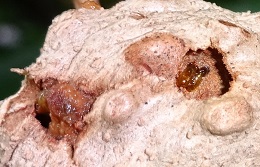
 Last weekend, I welcome the return of both the
Air Potato Beetle (Lilioceris cheni) and the Air Potato Bug
(Dalader species) to the nearby park. In fact, a week earlier on 5 July, I had noticed a lone beetle on an air potato.
The air potato vine in the vicinity was in a rather bad shape. On closer examination of the blown-up picture back home, there
appeared to be several freshly dug holes on the air potato. There might be larvae of the beetle hidden in these holes. The last
time that I saw it was around 2 years back.
Last weekend, I welcome the return of both the
Air Potato Beetle (Lilioceris cheni) and the Air Potato Bug
(Dalader species) to the nearby park. In fact, a week earlier on 5 July, I had noticed a lone beetle on an air potato.
The air potato vine in the vicinity was in a rather bad shape. On closer examination of the blown-up picture back home, there
appeared to be several freshly dug holes on the air potato. There might be larvae of the beetle hidden in these holes. The last
time that I saw it was around 2 years back.
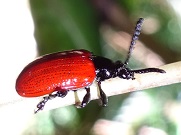
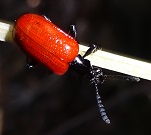
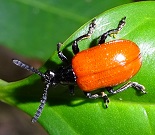 When I visited the site again a week later, I found at least 3 of them. One of them had orange hard wings instead of the usual red
ones. The orange instead of red colour could be due to the flash light from the camera. The beetle should be quite popular now in
the entomologist circle since its introduction in the United States (US) as a biological control agent against the
Air Potato Vine (Dioscorea bulbifera) in 2012. The US sample was collected
from China since it is not a native beetle in the US. There was not much information on this beetle when I first saw it in the wild
here September 2011.
When I visited the site again a week later, I found at least 3 of them. One of them had orange hard wings instead of the usual red
ones. The orange instead of red colour could be due to the flash light from the camera. The beetle should be quite popular now in
the entomologist circle since its introduction in the United States (US) as a biological control agent against the
Air Potato Vine (Dioscorea bulbifera) in 2012. The US sample was collected
from China since it is not a native beetle in the US. There was not much information on this beetle when I first saw it in the wild
here September 2011.
When the beetles are accompanied by the Air Potato Bug (Dalader species), the effect is very lethal on the air potato vine. Being a bug, the way it feeds is to pierce its sucking tube, a modified mouth part, into the twinning stem of the vine and suck out the plant fluid. When sufficient number of bugs gathered on the vine, the end time of the vine is quite certain. The beetles alone did not appear to be able to demolish the vine, likely due to its small number.
The bug is quite distinctive in term of its appearance. Its third segment of the antennae are dilated. The immature form or nymph does not have wings, a feature that is similar to the nymphs of other bugs. It is hard to spot this bug because its body colour is similar to the dried leaves of the vine.
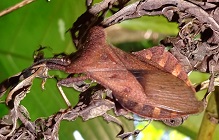
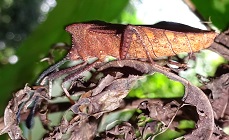
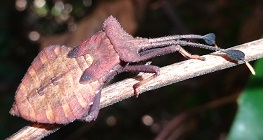
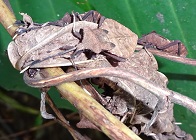
It is fun to investigate the links among insects and their host plants. The relationship may provide clues to their identity, both insect and plant. The mystery of the beetle is solved but I am still hoping to see a report on the bug that aid in its identification.